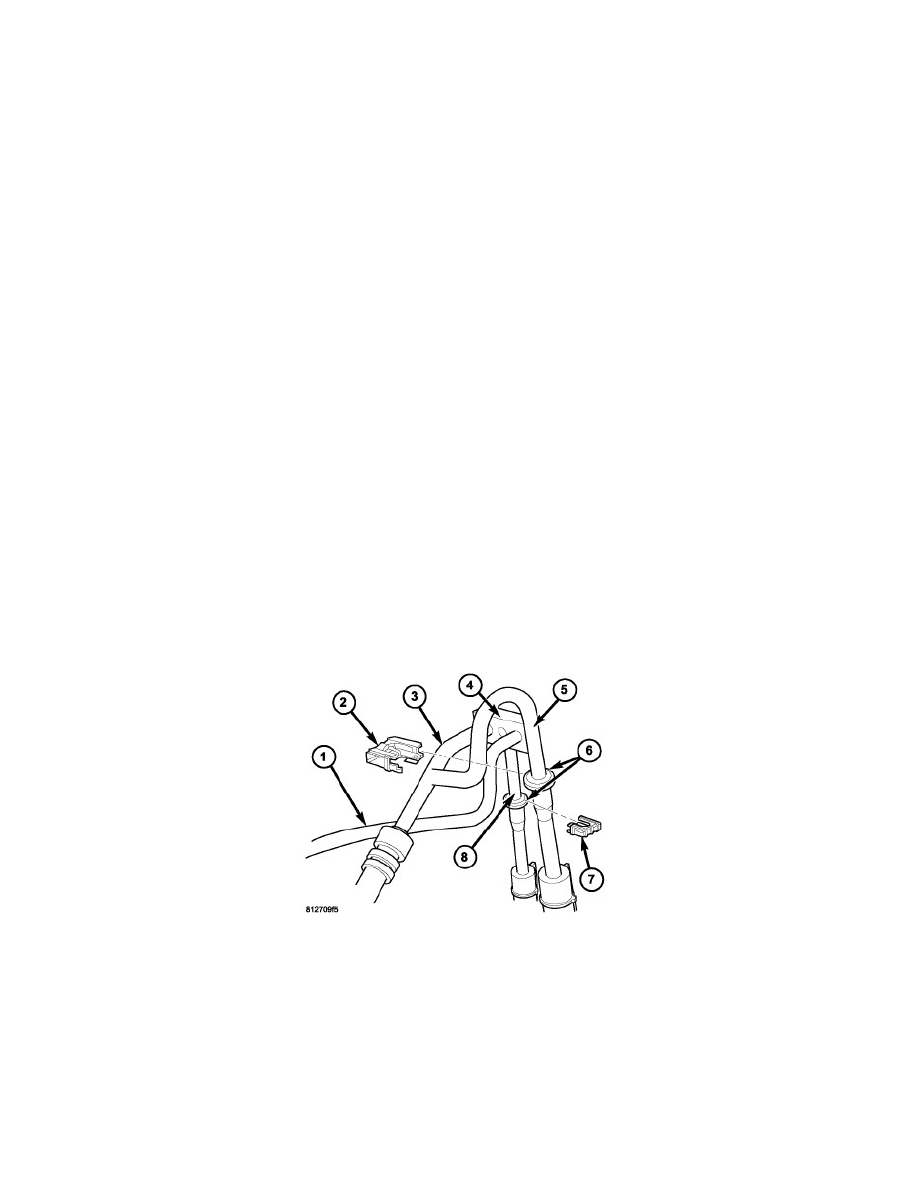Durango 2WD V6-3.7L (2009)

13. Install the A/C suction line (2) onto the A/C compressor (4).
14. Install the nut (1) that secures the A/C suction line to the A/C compressor. Tighten the nut to 23 Nm (17 ft. lbs.).
15. Install the air cleaner housing and resonator See: Engine, Cooling and Exhaust/Engine/Tune-up and Engine Performance Checks/Air Cleaner
Housing/Service and Repair/Air Cleaner Body - Installation.
16. Reconnect the negative battery cable.
17. Evacuate the refrigerant systemSee: Service and Repair/Refrigerant System Evacuate.
18. Adjust the refrigerant oil level See: Specifications/Capacity Specifications/Refrigerant Oil Capacity.
19. Charge the refrigerant system See: Service and Repair/Refrigerant System Charge.
Rear
INSTALLATION
CAUTION: Be certain to adjust the refrigerant oil level when servicing the A/C refrigerant system See: Specifications/Capacity
Specifications/Refrigerant Oil Capacity . Failure to properly adjust the refrigerant oil level will prevent the A/C system from
operating as designed and can cause serious A/C compressor damage.
CAUTION: Always use ND-11 Polyester (POE) oil from Mopar(R) in Hybrid Electric Vehicle (HEV) models. Never use Polyalkylene Glycol
(PAG) oil in an HEV model. See Refrigerant Oil for more information.
CAUTION: Polyalkylene Glycol (PAG) oil can contaminate the refrigerant system of a Hybrid Electric Vehicle (HEV) and lead to A/C system
damage and failure. If the refrigerant recovery/recycling and charging equipment was last used on a non-HEV model, flush the
hoses of the equipment with a solvent approved by the equipment manufacturer before using the equipment on an HEV model, or
use refrigerant recovery/recycling and charging equipment designated only for HEV models by your service facility. See the
operating instructions supplied by the equipment manufacturer for proper use and care of the refrigerant recovery/recycling and
charging equipment.
NOTE: When replacing multiple A/C system components, refer to the Refrigerant Oil Capacities chart to determine how much oil should be
added to the refrigerant system See: Specifications/Capacity Specifications/Refrigerant Oil Capacity .
NOTE: Replacement of the refrigerant line O-ring seals and gaskets is required anytime a refrigerant line is disconnected. Failure to replace
the rubber O-ring seals and metal gaskets could result in a refrigerant system leak.
NOTE: The A/C suction line connects between the A/C evaporator and the A/C compressor. On models equipped with the rear heating-A/C
system, the A/C suction line also includes an extension tube that connects the suction line to the underbody lines.
1. Install the A/C suction line (3) to the A/C compressor and the front A/C expansion valve See: A/C Suction Line - Installation.
2. Remove the tape or plugs from the refrigerant line coupler (6) and the underbody suction line.
3. Lubricate a new rubber O-ring seal with clean refrigerant oil and install it onto the refrigerant line coupler. Use only the specified O-ring as it is
made of a special material for the R-134a system. Use only refrigerant oil of the type recommended for the A/C compressor in the vehicle.
4. Connect the underbody suction line to the suction line extension tube (5) See: Coupler HVAC/Service and Repair/Refrigerant Line Coupler -
Installation.
5. Install the secondary retaining clip (2) onto the refrigerant line coupler.
WARNING: Always follow vehicle service procedures to properly connect batteries on an HEV model. Serious or fatal injury may result from
improper service procedures.
